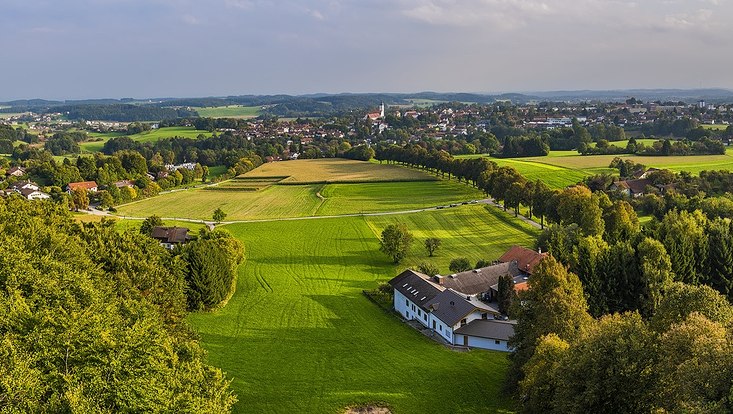and Natural Sciences
Securing Nature’s Contributions to People requires at least 20-25% (semi-)natural habitat in human-modified landscapes
22 January 2024, by MIN-Dekanat

Photo: pixabay/FelixMittermeier
A new study from the Earth Commission with contributions from the Department of Biology at Universität Hamburg reveals that people will miss out on many of the regulating and non-material benefits that nature provides, if natural spaces within human-modified areas are not strategically created and maintained.
While conservation efforts usually focus on protecting the half of the Earth’s land surface that remains intact and wild natural habitats, researchers argue that conservation in agricultural and urban lands can be just as important and should not be overlooked.
“The global community needs to look beyond protected and intact natural areas when talking about biodiversity, to recognise the vital presence of nature in all landscapes that people live in, that is in cultivated lands, cities and the countryside.” says lead author Dr. Awaz Mohamed from the Department of Biology at Universität Hamburg. “Human survival is dependent on the functioning of these landscapes. The mosaic of landscapes we live in provides all people with food, clean water and air, and protects from climate extremes and natural hazards, thereby enhancing our overall well-being.”
Benefits provided by nature to human beings (i.e., Nature’s Contributions to People, NCP) play a significant role in agricultural and urban landscapes. In an extensive literature review the authors of the current study explored six crucial NCP that can be sustained through nurturing semi-natural habitats and identified the minimum level of ‘functional integrity’ required in a landscape to maintain the provisioning of these NCP. Functional integrity is the capacity of an area to provide and sustain NCP based on the quantity, quality and spatial configuration of the habitat it contains, because it is not only important that some nature is present in human-modified landscapes, but also how much and which quality (e.g., species diversity and composition) and finally the spatial arrangement or the placement individual habitats have (e.g., accessibility for humans and other mobile organisms).
Dr. Mohamed explains: “Habitats strategically located in the landscape can significantly reduce the frequency, risk and impact of natural hazards such as shallow landslides, floods and soil erosion. Habitats in agricultural landscapes provide crucial space for pollinators and pest-regulating organisms. Habitats in urban ecosystems, in the form of green spaces and parks, can provide functions such as physically and psychologically beneficial experiences that contribute significantly to well-being.”
Through their review and synthesis of the existing evidence, the authors discovered that a minimum level of 20%-25% of (semi-)natural habitat per square kilometre needs to be present in a human-modified landscapes in order for the NCP to be maintained. They stress that this is the critical level, not the optimal level required to meet community demand (which may be higher or lower in specific instances). The authors found that below 10% habitat area per km2, most of the studied benefits provided by nature are lost almost completely; encompassing about 50% of global human-modified lands. “Based on land cover data from the European Space Agency, we found that only one-third of global human-modified lands meets this minimum level for NCP provisioning”, says Prof. Dr. Ina Meier of the Department of Biology at Universität Hamburg and co-author of the study. ”This finding emphasises the urgent need for policy interventions to restore and regenerate ecosystem functions and their contributions to human well-being in the remaining area”.
This study can be used to inform such policy interventions, as it provides the first comprehensive and widely applicable measurement of the minimum level of functional integrity needed across several NCP and a wide range of landscapes. The framework can serve as a general guide to identify priority locations for effective and targeted conservation and restoration strategies, to promote sustainable NCP provisioning and safeguard the well-being of people reliant on these ecosystems.
Specific approaches to enhance NCP provisioning vary depending on the context and have to be adapted and adopted to local context and conditions. “Meeting NCP demand, in many conditions and contexts, will require habitat quantity, quality and spatial distribution levels that are greater than the minimum values identified in the current study.” says Dr. Mohamed. “Engaging with local communities and implementing locally adapted practices are fundamental steps in identifying which NCP to prioritise and the critical habitats that provide them.”
Taking the importance of NCP and semi-natural habitats more seriously in conservation efforts will not only benefit people’s well-being, it will also help to restore habitats and their ecosystem functions and contribute to halting biodiversity loss by restoring landscape connectivity, which ultimately strengthens the resilience of agricultural and urban areas against climate change. With the accelerated global decline in biodiversity and consequently in NCP, this task has never been more urgent.
Original publication
Awaz Mohamed, Fabrice DeClerck, Peter H. Verburg, David Obura, Jesse F. Abrams, Noelia Zafra-Calvo, Juan Rocha, Natalia Estrada-Carmona, Alexander Fremier, Sarah K. Jones, Ina C. Meier, Ben Stewart-Koster (2024) Securing Nature’s Contributions to People requires at least 20%–25% (semi-)natural habitat in human-modified landscapes, One Earth; 7 (1), p. 59-71.
https://doi.org/10.1016/j.oneear.2023.12.008


